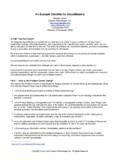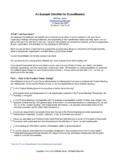Transcription of Understanding agile project management …
1 MANAGING DIGITAL LIBRARIES:THE VIEW FROM 30,000 FEETU nderstanding agile projectmanagement methods usingScrumH. Frank CervonePurdue University Calumet, Hammond, Indiana, USAA bstractPurpose This paper seeks to define and describe agile project management using the Scrummethodology as a method for more effectively managing and completing This paper provides a general overview and introduction to theconcepts of agile project management and the scrum methodology in agile project management using the scrum methodology allows project teams to managedigital library projects more effectively by decreasing the amount of overhead dedicated to managing theproject.
2 Using an iterative process of continuous review and short-design time frames, the project team isbetter able to quickly adapt projects to rapidly evolving environments in which systems will be This paper fills a gap in the digital library project management literature byproviding an overview of agile project management management , Digital libraries, project planningPaper typeGeneral reviewIn the past decade, project management has been undergoing a major transformationas it is applied to information system design. When you consider that traditionalproject management methodology originated from the body of knowledge of anentirely different domain (engineering, mainly of the industrial and civil kind), it is notsurprising that project management in the information systems arena has of the methods for developing systems originated in computer science whichitself emerged from constructs used in engineering and mathematics.
3 In the early daysof computing this sufficed, however today, developing systems is much more than justengineering the most technically correct or best system. In some cases, what we asusers may want is not the best system. Frequently, what we really want is the mostpractical system that is focused on and addresses our particular we consider traditional project management and software developmentapproaches, several disadvantages are immediately evident. For one, the huge effortrequired during the planning phase of a traditional project is often so all-encompassingthat half (or more) of the resources for the project are expended before any developmentwork even beings.
4 Furthermore, requirements definitions are often so labor intensiveand protracted that the requirements for the project have changed before developmenteven this context, agile project management current issue and full text archive of this journal is available ,118 Accepted October 2010 OCLC Systems & Services:International digital libraryperspectivesVol. 27 No. 1, 2011pp. 18-22qEmerald Group Publishing Limited1065-075 XDOI of agile project managementAgile project management is an outgrowth of the agile software developmentmovement. While the origins of agile project management can be traced back to ideasfrom a paper by Takeuchi and Nonaka in the January 1986 issue of theHarvardBusiness Review, it was not until Jeff Sutherland and Ken Schwaber discussed the firstagile method for software development at the 1995 OOPSLA conference that the idea ofgained traction.
5 While analyzing common software development processes, they foundthat traditional development approaches were not suitable for empirical, unpredictableand non-repeatable , there are several different approaches to implementing agile methods butunderlying all of the various agile movements are some basic concepts that turntraditional methodologies on their head. The Manifesto for agile SoftwareDevelopment stated four core principles:(1) Individuals and interactions over processes and tools.(2) Working software over comprehensive documentation.
6 (3) Customer collaboration over contract negotiation.(4) Responding to change over following a project management is deeply rooted in these principles but slightly modified tomake sense in the project management , rather than software development,environment. This can be seen in some of the qualities of the agile projectmanagement approach. For example, agile project management emphasizes twoimportant concepts. The first is that risk is minimized by focusing on short iterationsof clearly defined deliverables. The second is that direct communication with partnersin the development process is emphasized in lieu of creating copious projectdocumentation.
7 The reasons these two concepts are emphasized is simple: both help aproject team adapt quickly to the unpredictable and rapidly changing requirementsmost development projects are carried out are agile methods?Just as there are many types of projects, there are several different takes on how to bestapply agile methods. Some of the most important include: scrum , extreme projectmanagement, adaptive project management , and dynamic project managementmethod. Of these, the general model of scrum is most often who follow rugby know that a scrum is a way to restart the game after aninterruption.
8 Specifically, the forwards of each side come together in a tight formationand struggle to gain possession of the ball when it is tossed in among the teammembers. If you cannot envision this, do not worry. Much of the terminology of agilemethods is derived from rugby terms; it would seem partly as a way of bringing somelevity into the terms of agile project management , a scrum is simply an agile , lightweightprocess for managing and controlling software and product development in rapidlychanging environments. Like a scrum in rugby, it shares many of the samecharacteristics.
9 For example, agile project management Scrums are intentionallyiterative, incremental processes that are predicated on a team-based approach. Giventhat systems today are usually development in fluid and rapidly changingAgile projectmanagement19environments, one of the major reasons for using an iterative process is to help controlthe chaos that can result from conflicting interests and needs within the project , iterative processes are used to help enable improvement incommunication, maximize cooperation, as well as protect the team from disruptionsand impediments.
10 Overall then, the goal is to deliver a more suitable product morequickly than with traditional scrum in depthThe scrum model is built on three major components: roles, process, and artifacts. TheScrum Master is the role traditionally assumed by a project manager of team person is responsible for several things, perhaps the most important of which areenacting the scrum values and practices and removing impediments. The scrum teamtypically is a cross-functional team of consists of five to ten people who work on theproject full time. The team is self-organizing, which has been interpreted in variousways, but most often means that the leadership role within the team is not fixed andchanges depending on the needs of the specific iteration (known as a sprint) in processat the time.



